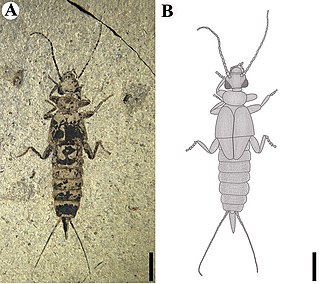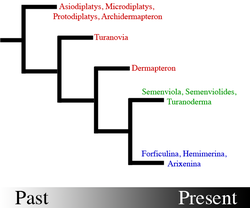
Earwigs make up the insect order Dermaptera. With about 2,000 species in 12 families, they are one of the smaller insect orders. Earwigs have characteristic cerci, a pair of forceps-like pincers on their abdomen, and membranous wings folded underneath short, rarely used forewings, hence the scientific order name, "skin wings". Some groups are tiny parasites on mammals and lack the typical pincers. Earwigs are found on all continents except Antarctica.

Forficula auricularia is a species complex comprising the common earwig. It is also known as the European earwig. It is an omnivorous insect belonging to the family Forficulidae. The name earwig comes from the appearance of the hindwings, which are unique in their resemblance to human ears when unfolded. The species name of the common earwig, auricularia, is a specific reference to this feature. The European earwig survives in a variety of environments. It is also a common household insect in North America. They are often considered a household pest because of their tendency to invade crevices in homes and consume pantry foods, though they may also act as beneficial species depending on the circumstances.

Forficulidae is a family of earwigs in the order Dermaptera. There are more than 70 genera and 490 described species in Forficulidae.

Archidermaptera is an extinct suborder of earwigs in the order Dermaptera. It is one of two extinct suborders of earwigs, and contains two families known only from Late Triassic to Early Cretaceous fossils. The suborder is classified on the basis of general similarities. The Archidermaptera share with modern earwigs tegmenized forewings, though they lack the distinctive forceps-like cerci of modern earwigs, have external ovipositors, and possess ocelli. The grouping has been suggested to be paraphyletic.

Arixeniidae is a family of earwigs in the suborder Neodermaptera. Arixeniidae was formerly considered a suborder, Arixeniina, but was reduced in rank to family and included in the new suborder Neodermaptera.

Hemimeridae is a family of earwigs in the suborder Neodermaptera. Hemimeridae was formerly considered a suborder, Hemimerina, but was reduced in rank to family and included in the new suborder Neodermaptera.

Protodiplatyidae is an extinct family of earwigs. It is one of three families in the suborder Archidermaptera, alongside Dermapteridae and Turanovia. Species are known from Jurassic and Early Cretaceous fossils and have unsegmented cerci and tarsi with four to five segments.
Microdiplatys is an extinct genus of earwigs, in the family Protodiplatyidae. It is one of only six genera in the family, its family being the only one in the suborder.
Protodiplatys is an extinct genus of earwigs, in the family Protodiplatyidae, the suborder Archidermaptera, and the order Dermaptera. It is known from three species, P. fortis and P. gracilis, which are known from the Middle-Late Jurassic Karabastau Formation in Kazakhstan, and P. mongoliensis from the Aptian aged Gurvan-Eren Formation of Mongolia.
Asiodiplatys is a monotypic genus containing the single species Asiodiplatys speciosus, an extinct species of earwig in the family Protodiplatyidae. It had long and thin cerci that were very different from modern species of Dermaptera, but tegmina and hind wings that folded up into a "wing package" that are like modern earwigs. Like Archidermapteron martynovi, the only clear fossil of the species was found in Russia.
Microdiplatys campodeiformis is an extinct species of earwig in the family Protodiplatyidae. It is one of only two species in the genus Microdiplatys, the other being Microdiplatys oculatus.
Turanovia incompleta is an extinct species of archidermapteran earwig. It is the only species in the genus Turanovia and family Turanoviidae. It is found in the Middle-Late Jurassic (Callovian-Oxfordian) Karabastau Formation of Kazakhstan.

Labia minor, the lesser earwig or small earwig, is a species of earwig. It is widespread globally in temperate climates, preferring warm locations such as compost heaps in parts of its range. It is 4–7 mm long, including the pincer, and chocolate brown in color.

Astreptolabis is an extinct genus of earwig in the Dermaptera family Pygidicranidae known from a group of Cretaceous fossils found in Myanmar. The genus contains two described species, Astreptolabis ethirosomatia and Astreptolabis laevis and is the sole member of the subfamily Astreptolabidinae.
Zigrasolabis is an extinct genus of earwig in the family Labiduridae known from Cretaceous fossils found in Myanmar. The genus contains a single described species, Zigrasolabis speciosa.
Toxolabis is an extinct genus of earwig in the dermapteran family Anisolabididae known from a Cretaceous fossil found in Burma. The genus contains a single described species, Toxolabis zigrasi.

Neodermaptera, sometimes called Catadermaptera, is a suborder of earwigs in the order Dermaptera. There are more than 2,000 described species in Neodermaptera.
Semenoviolidae is an extinct family of earwigs in the order Dermaptera. There are at least two genera and two described species in Semenoviolidae.

Dermapteridae is an extinct family of earwigs known from the Late Triassic to Mid Cretaceous, it is part of the extinct suborder Archidermaptera, alongside Protodiplatyidae and Turanovia. It was first named as a subfamily by Vishniakova in 1980, and elevated to family status by Engel in 2003 without discussion.










